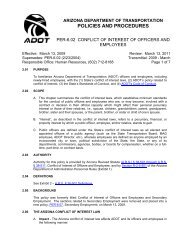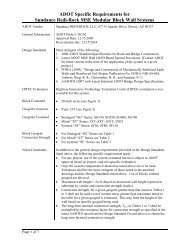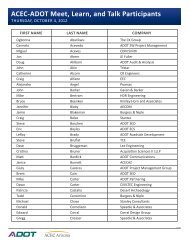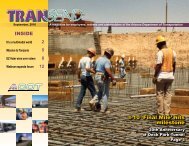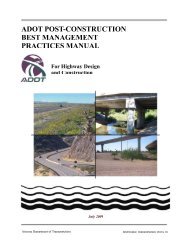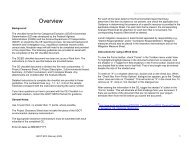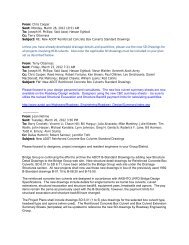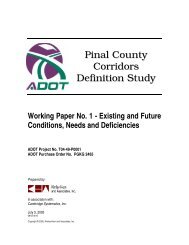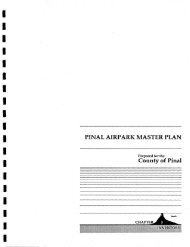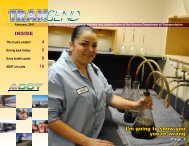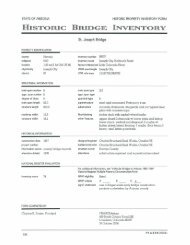I-10 Twin Peaks Traffic Interchange, Environmental Assessment
I-10 Twin Peaks Traffic Interchange, Environmental Assessment
I-10 Twin Peaks Traffic Interchange, Environmental Assessment
Create successful ePaper yourself
Turn your PDF publications into a flip-book with our unique Google optimized e-Paper software.
Affected Environment and <strong>Environmental</strong> Impacts October 2005<br />
segments of the project area within the Arizona Department of Transportation’s<br />
right-of-way to determine the invasive species present within the segment, treat<br />
these species prior to construction in accordance with the Section’s invasive<br />
species management plan, and continue any necessary treatments following<br />
construction completion.<br />
The contractor would clean all earth-moving and hauling equipment prior to its<br />
entering the construction site to prevent the introduction of invasive species.<br />
Additional invasive species mitigation, if needed, would be developed during final<br />
design using the invasive species survey. All disturbed soils would be seeded<br />
using native species to help prevent the reestablishment of invasive species.<br />
Conclusion<br />
As a result of the implemented mitigation measures, the preferred alternative<br />
would not assist in the spread of invasive species.<br />
Visual Resources<br />
The complete results of the visual resource investigations are presented in the<br />
document Interstate <strong>10</strong> <strong>Traffic</strong> <strong>Interchange</strong> at <strong>Twin</strong> <strong>Peaks</strong>/Linda Vista Visual<br />
Impact Analysis Report, dated February 5, 2004. Readers are referred to this report<br />
for the detailed findings; however, the results are summarized below.<br />
In a roadway improvement project, visual resources are considered from two<br />
perspectives: 1) the view from the roadway to motorists; and, 2) the view of the<br />
roadway to the surrounding community. Visual resources and effects to these<br />
resources are defined by identifying key views and considering community goals<br />
and preferences.<br />
Community goals and preferences are established in planning documents that<br />
address protection of visual resources. Two Town of Marana planning documents,<br />
the Town of Marana General Plan Update (November 2002) and the Park, Trail,<br />
and Open-Space System Master Plan (July 2000), address visual resources. The<br />
General Plan provides overall direction for future growth and development. While<br />
the General Plan does not dictate parcel-level land use decisions, it integrates land<br />
use, resource conservation, transportation, economic development, and public<br />
facilities and services into a comprehensive and coordinated strategy. Although the<br />
General Plan expresses clear goals of protection of significant scenic value<br />
viewsheds, no specific policies or strategies to address transportation facilities are<br />
included. Marana’s Park Plan was developed to accomplish several goals, one of<br />
which was to protect significant natural open space areas. The Park Plan describes<br />
open space areas like the Tortolita Mountains, Saguaro National Park (SNP), and<br />
unique biological communities such as the Santa Cruz River riparian area and the<br />
Tortolita Fan Ironwood Forest as important visual resources valued by the<br />
community.<br />
Interstate <strong>10</strong> <strong>Traffic</strong> <strong>Interchange</strong> at<br />
<strong>Twin</strong> <strong>Peaks</strong>/Linda Vista<br />
4-41<br />
Project No.: NH-0<strong>10</strong>-D (AIW)<br />
TRACS No.: <strong>10</strong> PM 236 H5838 01D



